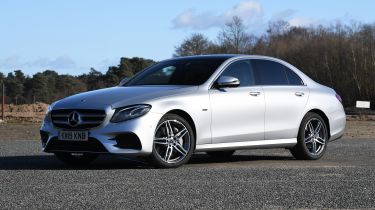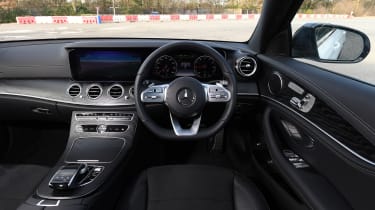Used Mercedes E-Class (Mk5, 2016-2023) review
Our full used buyer’s guide on the Mercedes E-class, covering the E-Class Mk5 that’s been on sale since 2016
Verdict
The most difficult thing about shopping for an E-Class is pinning down which model to buy. The range is incredibly complex, with petrol and diesel engines both available in regular, hybrid and plug-in-hybrid forms. Add in four different bodystyles, several trim levels (these came and went over time), plus a huge array of extra-cost options as well as option packs, and your head will be spinning just trying to work out what to go for. However, you can rest assured that whatever you buy, you’ll love it; the E-Class has scooped a slew of Auto Express awards since it arrived, including Premium Hybrid Car of the Year (2020, 2021), Executive Car of the Year (2020) and Large Company Car of the Year (2021). When you try one out, you will soon see why.
A new Mercedes E-Class is about to hit showrooms, and it’ll be the sixth take on a formula that was launched 30 years ago. The all-conquering W124 arrived in 1985, but it wasn’t sold as the E-Class until 1993; this was the first car to be marketed by Mercedes-Benz under that name.
The W124 set the standard in the executive sector, and while things are now a lot more competitive – and the class has shrunk as buyers have moved into SUVs – this is still a model that’s arguably as close to ideal as you can get.
Used - available now

2020 Mercedes
E Class
35,726 milesAutomaticDiesel2.0L
Cash £26,187
2022 Mercedes
E Class
46,558 milesAutomaticPetrol2.0L
Cash £26,763
2019 Mercedes
E Class
62,377 milesAutomaticDiesel2.0L
Cash £18,000
2020 Mercedes
E Class
56,910 milesAutomaticDiesel2.0L
Cash £22,700Luxurious, refined, safe, well equipped and supremely comfortable, the E-Class is one of those cars that it’s easy to think is overpriced, until you buy and run one. Then you’ll soon see that it’s worth every penny.
History
The E-Class Mk5 saloon arrived in January 2016, with 191bhp four-cylinder 2.0 E220d or 254bhp 3.0 V6 E350d diesel engines. An estate appeared in June 2016 in E220d guise; 148bhp E200d, E350d and 395bhp E43 AMG options were added that October.
A cabriolet was introduced in March 2017, with a coupe following a month later. Both came in E220d, E350d, 241bhp E300 (turbocharged 2.0 petrol) and 328bhp E400 4Matic (twin-turbo 3.0 V6 petrol) forms; a 429bhp V6 E53 AMG option was added in September 2018, for all four bodystyles.
Just before that, the 335bhp E400d replaced the E350d, and the E450 4Matic superseded the E400 4Matic. An August 2020 facelift brought design tweaks, extra driver-assistance systems, a redesigned dash and mild-hybrid tech for most engines.
Which one should I buy?
All powertrains give decent performance; the V6-powered models are especially enjoyable to drive because they’re so smooth and torquey. Every E-Class had a nine-speed auto gearbox as standard, with no manual option. The range kicked off with the SE, which featured 17-inch alloys (18-inch on hybrids), LED headlights, heated front seats, leather trim, DAB radio and nav, plus a 12.3-inch display as standard.
AMG Line trim brought 19-inch wheels, a bodykit, privacy glass and a black headlining. Premium added Surround View, matrix-LED headlights, seat memory, parking assist and wireless charging. To this the Premium Plus pack added an upgraded Burmester hi-fi, a panoramic glass roof and powered boot closing. The All-Terrain came with a factory-fitted electrically activated tow bar.
Alternatives to the Mercedes E-Class
The E-Class’s closest rival is BMW’s 5 Series, which as with the Mercedes, came in saloon and estate forms with superb powertrains. Most models have rear-wheel drive, but four-wheel drive is available for those who want it. All of these things are also true of the Audi A6, except that’s front-wheel drive unless you buy a quattro edition.
Less obvious options are the Lexus GS and its successor, the ES, which come in saloon form only, and solely with hybrid powertrains. We’d also check out the Volvo S90 and V90, which are great to drive, very safe and supremely comfortable.
The Jaguar XF still looks stylish and is worth considering, although it’s outclassed by the Mercedes in terms of its technology. You’ll get a lot more for your money, though.
What to look for
Four-wheel drive
The E220d saloon and estate were offered with 4Matic four-wheel drive from April 2017. All AMG cars came with 4Matic as standard.
E63
Launched in summer 2017, the E63 AMG came only in saloon and estate forms. The E63 had a 563bhp 4.0-litre V8; the E63 S had 603bhp on tap.
Soft-roader
In June 2017 the All-Terrain E350d arrived to take on Audi’s A6 Allroad. Sitting 39mm higher than the regular estate, it had 4Matic as standard.
Tyres
The SE, All-Terrain, E43 AMG, E53 AMG and E63 AMG all came with regular tyres and a can of sealant; AMG Line models had run-flats instead.
Reliability
Things to check include glitches with the air suspension, damaged paint (this was a bit thin on early cars) and slow-witted infotainment (software updates fix this). On diesels the exhaust sensors can fail, so put any potential purchase through an MoT to make sure it’ll pass.
Interior
The E-Class’s cabin reeks of quality, with superb fit and finish plus premium materials everywhere. The modern and hi-tech dashboard might initially seem daunting, but you soon get used to it.
Comfort levels are high, with excellent seats and superb refinement, and practicality is good, too. There is plenty of rear and boot space; the saloon can stow 540 litres (400 for hybrids), while the estate will swallow up to 1,820 litres with the seats folded. If they’re in use, it’s a still-generous 640, or 480 in a hybrid. Coupes and convertibles are less practical, but more usable than you might think.
Prices
Expect to pay at least £12,000 to buy a fifth-generation E-Class; this secures an early E220d SE saloon or estate with at least 100,000 miles on the clock. We found nearly 2,400 cars for sale, two thirds of which were diesels; E350ds are priced from £18,000 for a 100,000-mile example. Plug-in hybrids are relatively unusual, with the E300de diesel starting at £22,000 for a 120,000-mile AMG Line on a 19-plate; the E350e costs from £18,000 for a 17-plate SE that’s done 100,000 miles.
Coupes and convertibles start at £18,000 and £23,000 respectively, while the unusual E43 AMG costs £29,000-plus for an early saloon. The E53 is more plentiful and is priced from £38,000, while the ludicrously fast E63 starts at £45,000 and the E63 S carries a £5,000 premium.
Visit our Find a Car service to get a great deal on a used Mercedes E-Class, or to check prices on a specific model head over to our Free Car Valuation tool.
Running costs
All E-Classes need to be serviced every 12 months or 11,500 miles. Work alternates between minor and major, with the former priced at around £390, while the latter is £430-£740 depending on which service it is and therefore what replacement parts are needed. A new air filter costs around £60 (fitted), for example, while a fresh fuel filter is about twice as much.
Also recommended is spending £125 every other year for new brake fluid, while the coolant must be renewed every 10 years at about £150. All engines are chain-driven, with no cambelts to replace. The ServiceCare programme spreads maintenance costs.
Recalls
With 55 so far, we think this E-Class holds the record for the most recalls of any used car we’ve ever covered. There have been nine campaigns because of seatbelt faults, two each because of potentially problematic airbags and glitches in the emergency-call system, plus one because crankshaft-manufacturing faults might lead to the need for a replacement engine.
Other potential issues include faulty headrests in the convertible, turbocharger oil leaks, chafed wiring looms and the exhaust working loose. Recalls were issued because of incorrect Isofix mountings being installed, fuel leaks and rear spoilers coming adrift altogether. Steering problems led to six separate recalls, there was another due to faulty timing chains, and software glitches led to no fewer than 10 different campaigns.
Driver Power owner satisfaction
Considering the E-Class was unveiled nearly eight years ago, 43rd out of 75 in the 2023 Driver Power new-car survey isn’t a disaster. Top-10 scores for the cabin quality and design, brakes and ventilation were the high points, while owners also like the infotainment, all-round visibility, gearbox and seat comfort. What they don’t like are the high running costs, poor value, iffy reliability and some switchgear placement.
Looking to sell your current car quickly and for a good price? Try our Free Car Valuation tool today!











